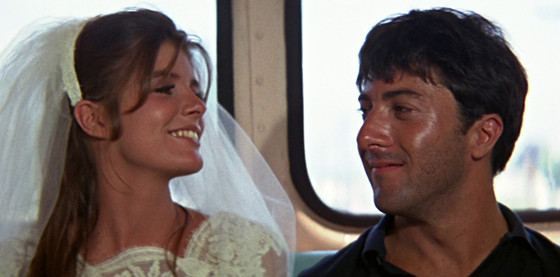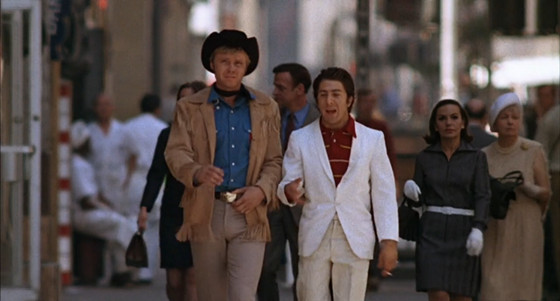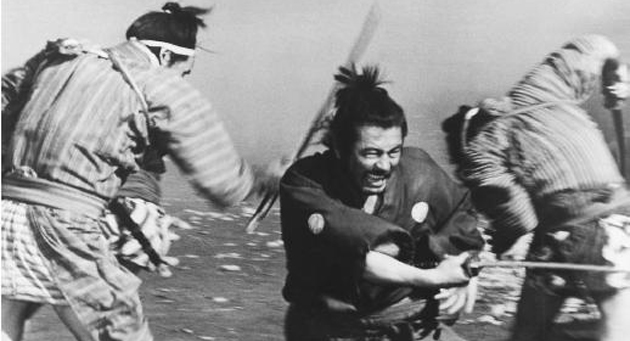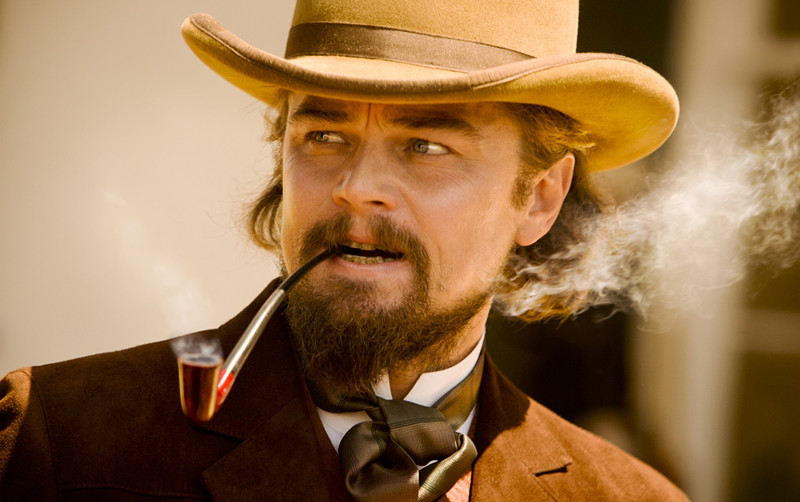5. The Graduate – Final Scene

Mike Nichols’ The Graduate was a revolutionary film in every expression. It included a mother-daughter love triangle, sexy innovative scenes, and a very fresh and dynamic way of telling a romantic story.
Benjamin Braddock declares his final love for Elaine Robinson. They ride into the sunset in a bus. As they sit in the back, both of them laugh joyously in perpetual happiness. But then the camera stays there, and both of them start to get more serious and thoughtful. This is interpreted as the couple starting to worry about their future, and what they were going to do. It gives the movie a special ending, leaving audiences wondering, and empathizing about the unknown destiny.
But in reality, it was just the camera not cutting by accident, and the two of them trying to stay in character for another take. Mike Nichols liked it so much he decided it should be his movie ending.
4. Midnight Cowboy – I’m walking here!

This is one of the most known movie accidents. And for a reason! Midnight Cowboy is a perfect representation of the end of The Summer of Love with a John Voight trying to make it in New York, and a sick, dirty, crazy Dustin Hoffman losing his mind. Both of them don’t seem to catch a break and are left alone, like little kids, in a jungle.
In one of the scenes, as both of them walk by, the street was closed for the shoot. A taxi in Manhattan cared too little about it and just ran the stop sign, almost hitting Hoffman. He stayed in character and punched the car screaming “I’m walking here!” Director John Schlesinger liked it so much that he had the scene re-done several times with that exact Hoffman reaction. It works so well because that’s his character, a distracted, angry, insane person.
3. Sanjuro – Last Scene

Legendary director Akira Kurosawa changed the way we see and feel films. He made samurai movies different, filled with emotion, perfect craft, and incredible visual images.
In Sanjuro, the sequel to Yojimbo, there supposed to be a final fight, in which our hero faces-off his enemy, Hanbei. The fight ends in its first second, as they both take out their swords and Sanjuro kills in one strike. As he does, blood comes out spilling from Hanbei’s chest. It is a blood bath. They have previously installed a hose in the actor playing Hanbei, and when Sanjuro hits him the hose breaks, ending up in a massive splash of blood. Everybody maintained character and Kurosawa left this on the final cut of the movie. Opening the way for more gory, bloody westerns, and horror films.
2. Django Unchained – Real Injury

It is well known that Leonardo DiCaprio is one of the most talented, capable actors working to date. He constantly sets the bar higher for himself, giving amazing performances in a range that few actors can do. In Django Unchained, he plays Calvin Candie, a plantation owner, and a complete and absolute batshit racist.
There is a scene in which he realizes that Schultz and Django are both conning him and he is gracefully falling for it. He slams the table in anger, and hits glass. Blood starts running through his hand and finger, as he says that he is going to kill Django’s loved one if he doesn’t get his way. This wasn’t planned and DiCaprio actually cut himself, stayed in character, and added the cut and blood to his performance, making it more scary and gruesome.
The blood falling in his pipe and fingers becomes a very difficult image to forget, and it stands as a great DiCaprio performance.
1. Jaws – Jaws Technology

When Spielberg began filming Jaws, he had the complete intention of showing the shark a lot. Unfortunately, (or fortunately enough) the prop was just not good, it encountered a bunch of difficulties, and was pretty much un-usable.
Spielberg then decided to just show his dorsal, and a few images of his face. This, says Spielberg, helped the movie be more of a Hitchcock style, “Less Is more”. It ended up being more scary to just see the shark announcing himself, and it holds up great with time, only letting us see snippets of the prop.
Today Jaws stands as one of the most iconic films in the second half of the 20th century horror films.